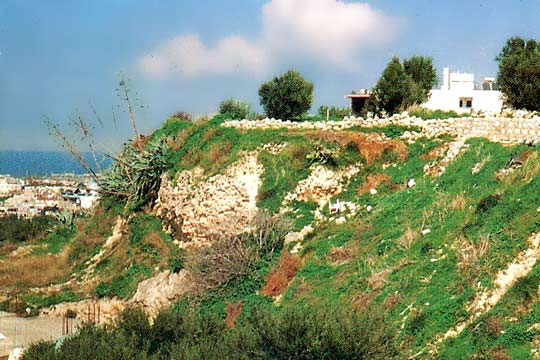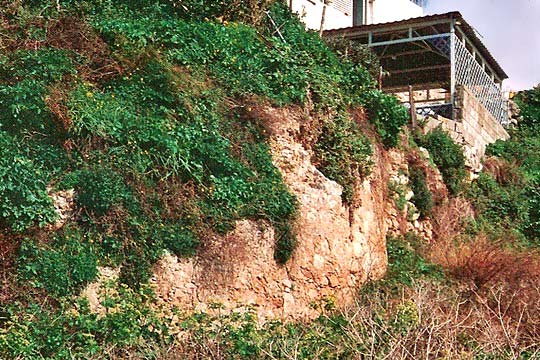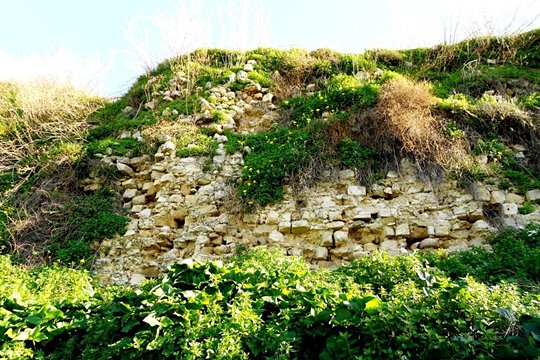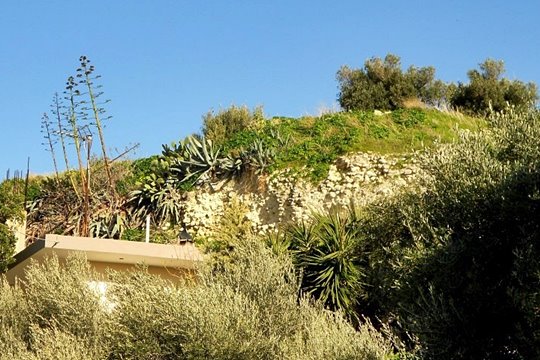Heraclion, Heraklion, Herakleion,Crete
Inadiye fortress
| Location: |
| On a hill at the Fortezza suburb of the city of Heraklion in Crete |
| Region > Prefecture: | 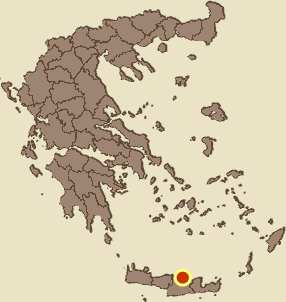 |
| Crete Herakleion | |
| Municipality > Town: | |
| City of Heraklion • Heraclion | |
| Altitude: | |
|
Elevation ≈ 183 m (Relative Height≈15 m) |
| Time of Construction | Origin | |
| 1650 | OTTOMAN |
|
| Castle Type | Condition | |
| Castle Ruins |
Few Remains
|
Few remains of a fortress that was built by the Ottomans to be used primarily as a winter camp during the long siege of the city of Helaclion (then called Candia) in the 17th century.
The Name of the Castle
The Ottomans called the fortress Kal’a-ı Cedid which means new fortress. Later it became known as “Inadiye” eloquently manifesting the obstinacy (Turkish:inad) of the besiegers during the long siege of Candia.
In Venetian reports, Inadiye is recorded as “Fortezza Città del Turco” and later, sarcastically, “ Nuova Candia”.
History
The siege of Candia lasted 21 years: from 1st May 1648 until 25th August 1669. It is by far the longest siege in the world history. The Ottomans had invaded Crete in 1645 and until 1648, they had conquered most of the island except from some fortresses and Candia.
However, the Ottoman army was not able (and was not to before two more decades, until 1669) to conquer the fortress of Candia (Ott. Kandiye, mod. Heraklion), the Venetian capital of Crete. This was mainly the result of Venice’s successful strategy of blockading the Dardanelles with its fleet, thus preventing the regular supply of the Cretan expedition from Istanbul with men and ammunition.
The serdar Deli Hüseyin Paşa, the commander of the Ottoman army in Crete between 1646 and 1658, who had deployed his troops outside Candia already in the summer of 1647, was waiting in vain for the necessary reinforcements fo the siege of the Venetian stronghold.
In the summer of 1649, the serdar encountered a rebellion of his soldiers, who refused to enter the trenches before the expected arrival of the fleet and even looted and burnt down his headquarters in the camp of the besiegers. The soldiers demanded permission to leave the island and return to their homes.
Later, in the autumn of the same year, after an unsuccessful effort against the walls of Candia, the soldiers requested from the Pasha permission to leave the trenches and spend the winter in fortresses which should be built around the besieged town.
So the building of the new fortress was decided and approved by the the imperial council.
The decision shows the decisiveness of the Ottoman leadership in Istanbul and Crete to adapt themselves to the circumstances of a long siege. The construction started in April 1650 and finished within 3 months.
The Venetians of Candia immediately after the construction of the fortress sent a spy to prepare a detailed plan of it, now preserved in the Archivio di Stato in Venice.
Besides its defensive function, the Kal’a-I Cedid was to be also, or even primarily, a center of the Ottoman soldiers’ social life in Crete during the long siege of Candia. The new fortress became the heart of a kind of a town for the besiegers of the Ottoman imperial camp, an Ottoman Candia out-side Venetian Candia. The fortress, according to the description of Evliya Çelebi, had 500 houses made of stone, an armoury (cebehane), storehouses for food, cisterns, and three fountains. Its inhabitants were served by six places of worhip inside its walls, the biggest one being the stone-built mosque of Sultan İbrahim, with six domes. In any case, however, the necessities for the siege were all around the fortress. The İbrahim Mosque had no minaret, for fear of being a target of the enemy’s artillery. Moreover,it was not functioning: it was used as a powder magazine, guarded night and day by the garrison, which consisted of 300 men under a dizdar.
Outside the fortress, to the west and north of it, a much bigger settlement was created by the besiegers. Evliya Çelebi describes it in 1667-1668 as “the great suburb of İnadiye” (varoş-I azîm-I İnadiye). According to him, the suburb included 77,000 houses and rooms for the unmarried men. It had seven mosques, again without minarets, and covered with earth, and a total of 2,000 workshops. All the buildings, however, were made of wood and rubbish.
For the standards of those days, it was a big city.
The final phase of the siege started in 1666 when the Grand Vizier Köprülü Fazıl Ahmed Pasha arrived on the island of Crete with reinforcements.
The plans of the Grand Vizier for the conquest of Candia made the Ottoman town of İnadiye unnecessary, or even an obstacle. In the winter of 1667-1668, the Vizier ordered the soldiers to build small rooms in the trenches before the walls instead of retreating to the suburb of İnadiye. The soldiers had to spend one more winter, that of 1668-1669, in the trenches outside Candia. It is interesting to note that in the spring of
1669, the Grand Vizier had to cope twice with a rebellion of 500 serdengeçtis who demanded to leave the trenches.
Eventually, it was also because of this tension that, according to Evliya Çelebi, Fazıl Ahmed Paşa ordered the soldiers to pull down the houses in the suburb of İnadiye, including the hans, the mosques and the market place in order to use the wood for the offensive constructions against the walls of Candia. This impressive event is also confirmed by Venetian sources.
In 1669 after failed efforts by Europeans to help, the Venetian commander Francesco Morosini after long negotiations he accepted the Turkish terms and surrendered .
Evliya Çelebi reports that the fortress was demolished after the capture of Candia, but this is not true. The fort was neglected and lost its significance but its usage as a military camp for small units continued. Sometime, probably in the 19th century, it was abandoned and gradually was ruined and replaced by newer constructions.
Structure, Fortification & Buildings
The fortress was built of stone and filled in with earth. It had a pentagonal shape, with five ramparts, and four gates: the Gate of Candia (Kandiye Kapısı) to the north, the Gate of the Mountain (Dağ Kapısı) to the south, opposite mount Youhtas, the Gate of the Suburb (Varoş Kapısı) to the west, and a fourth gate to the east.
The fortress, according to the Venetian design had six ramparts with cannons on them. The contemporary Venetian reports emphasize that it was built hastily, using quicklime, a fact which resulted in the collapse of some of its parts at the beginning of the next winter. This could explain why Evliya Çelebi described it later as having only five ramparts.
| First entry in Kastrologos: | June 2015 |
Sources
- ΣΤΕΡΙΩΤΟΥ ΙΩΑΝΝΑ, «Νέα Στοιχεία για το φρούριο των Τούρκων Νέα Κάντια στον οικισμό Φορτέτζα του Ηρακλείου», Κρητικά Χρονικά, 26, 1986, 137-151
- Elias Kolovos, “A TOWN FOR THE BESIEGERS: SOCIAL LIFE AND MARRIAGE IN OTTOMAN CANDIA OUTSIDE CANDIA (1650-1669)”, Halcyon Days in Crete VI, A symposium held in Rethymno, 13-15 January 2006, Crete UNIVERSITY PRESS, page103, and online here
- Information sent by Mr. Ioannis Dedes
|
|
| Access |
|---|
| Entrance: |
| Free access |



